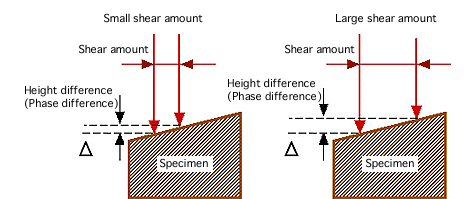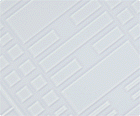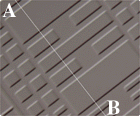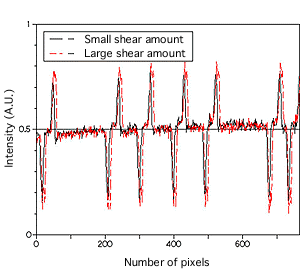Shear amount and contrast
While the resolving power of an image deteriorates when the shear amount is large, the contrast of the image, on the other hand, actually increases.
This is easy to understand when we consider a sloping specimen as shown in Figure 3. Contrast increases, because the difference (D) in the optical path of light that is split in two also increases when the shear amount is large. (Figure 4)
Figure 3. Difference in contrast between small shear amount and large shear amount

Figure 4. Example of image where contrast of DIC image changes with the shear amount

IC viewed under brightfield

IC viewed under small shear

IC viewed under large shear
-
The pattern is not clearly visible in the brightfield image, but in the DIC image it is clearly visible with greater contrast. The contrast in images with a large shear amount is greater than the contrast in images with a small shear amount .
Sample: IC pattern
Magnification: 10x
In addition, strength profiles for the lines between points A and B in an IC image viewed with different amounts of shear in Figure 4 are given below. (Figure 5)

Figure 5. Line profiles between points A and B in an IC image viewed with different amounts of shear in Figure 4
-
The graph above shows that while contrast in the image with a large shear amount is greater than the contrast in the image with a small shear amount, the line in the former image is wider, indicating this image has lower resolution than the image with the small shear amount.
The images and the graph show that instead of low contrast, images with a small shear amount have a narrower line, i.e. high resolution, while images with a large shear amount have a wider line, i.e. low resolution, instead of high contrast.
Resolution and contrast in DIC observation thus have a trade-off relationship that is determined by the shear amount . In general DIC microscopes, the shear amount is determined after a balance between resolution and contrast is considered, but since different specimens require different balances of resolution and contrast, some products allow the user to make selections that give priority to either high resolution or high contrast.
Though we based these explanations on a reflection-type microscope configuration, the principles are exactly the same in the case of transmitted-light type microscopes. With the transmitted-light type, however, a total of two prisms needs to be inserted into the optical path, one that splits the illuminating beam and another that recombines the observation light after it has passed through the specimen.

